Narbonne
Narbonne (/nɑːrˈbɒn/, also US: /-ˈbɔːn, -ˈbʌn/,[3][4][5] French: [naʁbɔn]; Occitan: Narbona [naɾˈbunɔ]; Latin: Narbo [ˈna(ː)rboː]; Late Latin: Narbona) is a commune in southern France in the Occitanie region. It lies 849 km (528 mi) from Paris in the Aude department, of which it is a sub-prefecture. It is located about 15 km (9 mi) from the shores of the Mediterranean Sea and was historically a prosperous port, but declined from the 14th century following a change in the course of the Aude River. It is marginally the largest commune in Aude, although the prefecture is the slightly smaller commune of Carcassonne.
Narbonne | |
|---|---|
Subprefecture and commune | |
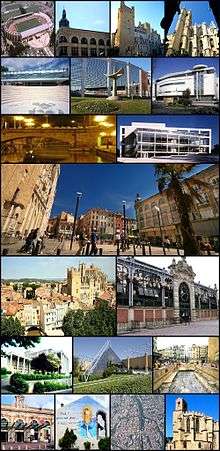 From left to right, top to bottom: The Parc des sports et de l'amitié stadium; historic department store Aux Dames de France; the Archbishop's Palace; Saint-Just-et-Saint-Pasteur Cathedral; the Médiathèque library and multi-media center; a sculpture on the stadium grounds; the Hall of Justice; Voltaire Bridge; the Narbonne Théâtre; City Hall square; Merchants' Bridge with a view of the Archbishop's Palace; the Cathedral and the Canal de la Robine; Les Halles covered market; the Palais des Sports, des Arts et du Travail sports, arts and work complex; the Espace de Liberté multi-use center; the Via Domitia; the Narbonne train station; Charles Trenet, born in Narbonne; an aerial view of the city center; former church Notre-Dame de Lamourguier, now the Lapidary Museum | |
 Flag  Coat of arms | |
Location of Narbonne 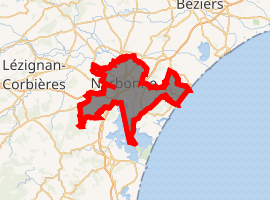
| |
 Narbonne 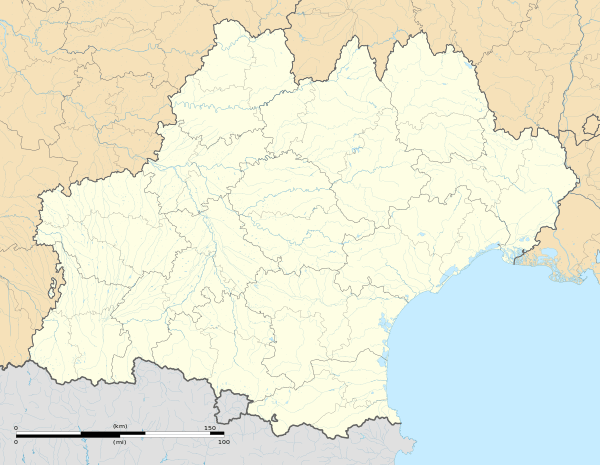 Narbonne | |
| Coordinates: 43°11′01″N 3°00′15″E | |
| Country | France |
| Region | Occitanie |
| Department | Aude |
| Arrondissement | Narbonne |
| Canton | Narbonne-1, 2 and 3 |
| Intercommunality | Narbonne |
| Government | |
| • Mayor (2014–2020) | Didier Mouly (PS) |
| Area 1 | 172.96 km2 (66.78 sq mi) |
| Population (2017-01-01)[1] | 54,700 |
| • Density | 320/km2 (820/sq mi) |
| Demonym(s) | Narbonnese (en)[2] narbonnaise (fr) |
| Time zone | UTC+01:00 (CET) |
| • Summer (DST) | UTC+02:00 (CEST) |
| INSEE/Postal code | 11262 /11100 |
| Elevation | 0–285 m (0–935 ft) |
| 1 French Land Register data, which excludes lakes, ponds, glaciers > 1 km2 (0.386 sq mi or 247 acres) and river estuaries. | |
Geography
Narbonne is linked to the nearby Canal du Midi and the Aude River by the Canal de la Robine, which runs through the centre of town. It is very close to the A9 motorway, which connects Montpellier and Nîmes to Perpignan and, across the border, to Barcelona in Spain. There is also a recently renovated train station which serves the TGV to Spain, Paris and Calais, which in turn connects to the Eurostar.
Etymology
The source of the town's original name of Narbo is lost in antiquity, and it may have referred to an Iron Age hillfort close to the location of the current settlement or its occupants.[6] The earliest known record of the area comes from the Greek Hecataeus of Miletus in the fifth century BC, who identified it as a Celtic harbor and marketplace at that time, and called its inhabitants the Ναρβαῖοι. In ancient inscriptions the name is sometimes rendered in Latin and sometimes translated into Iberian as Nedhena.
History
Narbonne in its current location was established in Gaul by the Romans in 118 BC, as Colonia Narbo Martius, colloquially Narbo. It was located on the Via Domitia, the first Roman road in Gaul, built at the time of the foundation of the colony, and connecting Italy to Spain. Geographically, Narbonne was therefore located at a very important crossroads because it was situated where the Via Domitia connected to the Via Aquitania, which led toward the Atlantic through Tolosa and Burdigala. In addition, it was crossed by the Aude River. Surviving members of Julius Caesar's Legio X Equestris were given lands in the area that today is called Narbonne.
Politically, Narbonne gained importance as a competitor to Massilia (Marseille). Julius Caesar settled veterans from his 10th Legion there and attempted to develop its port while Marseille was supporting Pompey. Among the products of Narbonne, its rosemary-flower honey was famous among Romans.[7]
Later, the province of Transalpine Gaul was renamed Gallia Narbonensis after the city, which became its capital. Seat of a powerful administration, the city enjoyed economic and architectural expansion. At that point, the city is thought to have had 30,000–50,000 inhabitants, and may have had as many as 100,000.[8]
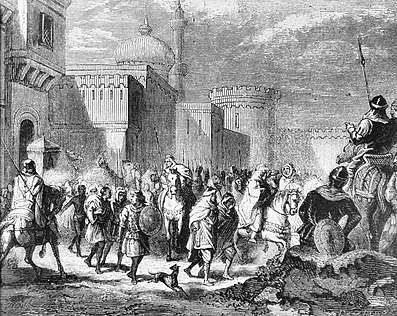
According to Hydatius, in 462 the city was handed over to the Visigoths by a local military leader in exchange for support, as a result Roman rule ended in the city. It was subsequently the capital of the Visigothic province of Septimania, the only territory from Gaul to fend off the Frankish thrust after the Battle of Vouille (507). For 40 years, from 719 to 759, Narbonne was part of the Umayyad Empire. The Umayyad governor Al-Samh captured Narbonne from The Kingdom of Visigoths in 719. The Carolingian Pepin the Short conquered Narbonne from the Arabs in 759 after which it became part of the Carolingian Viscounty of Narbonne. He invited, according to Christian sources, prominent Jews from the Caliphate of Bagdad to settle in Narbonne and establish a major Jewish learning center for Western Europe.[9] In the 12th century, the court of Ermengarde of Narbonne (reigned 1134 to 1192) presided over one of the cultural centers where the spirit of courtly love was developed.
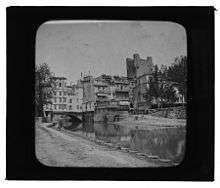
In the 11th and 12th centuries, Narbonne was home to an important Jewish exegetical school, which played a pivotal role in the growth and development of the Zarphatic (Judæo-French) and Shuadit (Judæo-Provençal) languages. Jews had settled in Narbonne from about the 5th century, with a community that had risen to approximately 2000 in the 12th century. At this time, Narbonne was frequently mentioned in Talmudic works in connection with its scholars. One source, Abraham ibn Daud of Toledo, gives them an importance similar to the exilarchs of Babylon.[10] In the 12th and 13th centuries, the community went through a series of ups and downs before settling into extended decline.
Narbonne loses its river and port
Narbonne itself fell into a slow decline in the 14th century, for a variety of reasons. One was due to a change in the course of the Aude River, which caused increased silting of the navigational access. The river, known as the Atax in ancient times, had always had two main courses which split close to Salelles; one fork going south through Narbonne and then to the sea close to the Clappe Massif, the other heading east to the etang at Vendres close to the current mouth of the river well to the east of the city. The Romans had improved the navigability of the river by building a dam near Salelles and also by canalising the river as it passed through its marshy delta to the sea (then as now the canal was known as the Robine.) A major flood in 1320 swept the dam away. The Aude river had a long history of overflowing its banks. When it was a bustling port, the distance from the coast was approximately 5 to 10 km (3 to 6 mi), but at that time the access to the sea was deep enough when the river was in full spate which made communication between port and city unreliable.[11] However, goods could easily be transported by land and in shallow barges from the ports (there were several: a main port and forward ports for larger vessels; indeed the navigability from the sea into the etang and then into the river had been a perennial problem)
The changes to the long seashore which resulted from the silting up of the series of graus or openings which were interspersed between the islands which made up the shoreline (St. Martin; St. Lucie) had a more serious impact than the change in course of the river. Other causes of decline were the plague and the raid of Edward, the Black Prince, which caused much devastation. The growth of other ports was also a factor.
Narbonne Cathedral
Narbonne Cathedral, dedicated to Saints Justus and Pastor, provides stark evidence of Narbonne's sudden and dramatic change of fortunes when one sees at the rear of the structure the enormously ambitious building programme frozen in time, for the cathedral—still one of the tallest in France—was never finished. The reasons are many, but the most important is that the completed cathedral would have required demolishing the city wall. The 14th century also brought the plague and a host of reasons for retaining the 5th-century (pre-Visigothic) walls.
Yet the choir, side chapels, sacristy, and courtyard remain intact, and the cathedral, although no longer the seat of a bishop or archbishop, remains the primary place of worship for the Roman Catholic population of the city, and is a major tourist attraction.
Building of the Canal de la Robine
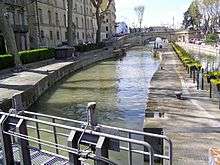
From the sixteenth century, eager to maintain a link to important trade, the people of Narbonne began costly work to the vestiges of the Aude River's access to the sea so that it would remain navigable to a limited draft vessel and also serve as a link with the Royal Canal. This major undertaking resulted in the construction of the Canal de la Robine, which was finally linked with the Canal du Midi (then known as the Royal Canal) via the Canal de Jonction in 1776. In the 19th century, the canal system in the south of France came into competition with an expanding rail network, but kept some importance due to the flourishing wine trade.
Hence, despite its decline from Roman times, Narbonne managed to hold on to its vital but limited importance as a trading route, particularly in more recent centuries.
Population
|
|
|
|
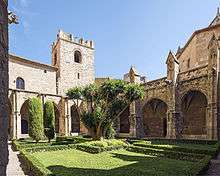
Sights
- The cathedral dating from 1272
- The Palais des Archevêques, the Archbishop's Palace, and its donjon with views over Narbonne
- Musée Archeologique, an archaeological museum in the town centre (currently closed - November 2019, most sections will be moved to new museum Narbo Via which is planned to open in September 2020)
- Clos de la Lombarde - an archaeological site presenting the vestiges of Roman townhouses, bath houses, workshops from the 1st century BC to the 3rd century AD and the first Christian basilica in Narbonne (3rd/4th century AD). Link to website: http://www.amiscloslombarde.fr/ (site in French and English)Archaeological Site Clos de la Lombarde
- The Roman Horreum, a former grain warehouse, built underground as a cryptoporticus
- Remains of the Via Domitia in the city center
- The canal, Canal de la Robine, running through the centre of the town
- The Halles covered market operates every day. The busiest times are Sunday and Thursday mornings.
- The nearby limestone massif known as La Clape and the beach at Narbonne plage
Sport
Narbonne is home to the rugby union team RC Narbonne founded in 1907. They play at the Parc des Sports Et de l'Amitié (capacity 12,000). They wear orange and black.
Transport
The Gare de Narbonne railway station offers direct connections to Paris, Barcelona, Toulouse, Marseille and many regional destinations. An extensive local system of buses and routes operated by Citibus.fr allow for easy public transport within Narbonne and surrounding communities. Travellers wishing to connect by plane arrive by airports in nearby Béziers, Carcassonne, Perpignan, Toulouse or Montpellier, as Narbonne does not have an airport.
Personalities
- Léon Blum was born in Paris but was elected as Deputy for Narbonne in 1929, re-elected in 1932 and 1936.
- Makhir of Narbonne, medieval Jewish scholar.
- Moshe ha-Darshan (11th century), chief of the yeshiva of Narbonne
- Bonfilh, a Jewish troubadour from the city.
- Kalonymus ben Todros, (d. ca. 1194) was a Provençal rabbi who flourished at Narbonne in the second half of the twelfth century.
- Saint Sébastien, third-century Christian saint and martyr.
- Dimitri Szarzewski, rugby player.
- Charles Trenet, singer and songwriter.
- Guillaume Barthez de Marmorières, (1707-1799), civil engineer.
- Jean-Joseph Cassanéa De Mondonville, (1711-1772) violinist and composer.
- Rabbi Moshe ben Yosef, Head of the Talmudic Academy of Narbonne in the 12th Century.
- Anaïs Napoleón, photographer.
International relations
References
- "Populations légales 2017". INSEE. Retrieved 6 January 2020.
- The forms "Narbonian" and "Narbonensian" are sometimes encountered, particularly in reference to ancient Narbo and Narbonnese Gaul.
- "Narbonne". The American Heritage Dictionary of the English Language (5th ed.). Boston: Houghton Mifflin Harcourt. Retrieved 27 April 2019.
- "Narbonne". Oxford Dictionaries UK Dictionary. Oxford University Press. Retrieved 27 April 2019.
- "Narbonne". Merriam-Webster Dictionary. Retrieved 27 April 2019.
- Riess, Frank (2016). Narbonne and its Territory in Late Antiquity: From the Visigoths to the Arabs. Routledge. p. 34. ISBN 9781317090700.
- Maguelonne Toussaint-Samat (Anthea Bell, tr.) The History of Food, 2nd ed. 2009:23.
- 1
- Trigano – The Conventionalism of social Bonds and the Strategies of Jewish Society in the Thirteenth Century; Byrd – The Jesus Gene: A messianic Bloodline, the Jews and Freemasonry accessdate=2012-02-16
- Jewish encyclopedia.
- Mediterranean Beaches and Bluffs: A Bicycle Your France E-guide by Walter Judson Moore, 2015
- Annuaire-Mairie.fr. "Ville d'Aoste" (in French). Retrieved 18 June 2013.
- "British towns twinned with French towns". Archant Community Media Ltd. Retrieved 11 July 2013.
- Salford City Council. "Salford's twin towns". Salford.gov.uk. Archived from the original on 17 December 2007. Retrieved 4 May 2008.
- Michel Gayraud, Narbonne antique des origines à la fin du IIIe siècle. Paris: De Boccard, Revue archéologique de Narbonnaise, Supplément 8, 1981, 591 p.
- Histoire de Narbonne, Jacques Michaud and André Cabanis, eds, Toulouse: Privat, 2004.
- L’Aude de la préhistoire à nos jours (under the direction of Jacques Crémadeilis), Saint-Jean-d’Angély, 1989.
- Les Audois : dictionnaire biographique, Rémy Cazals et Daniel Fabre, eds., Carcassonne, Association des Amis des Archives de l’Aude, Société d’Études Scientifiques de l’Aude, 1990.
Further reading
- "Narbonne", A Handbook for Travellers in France (8th ed.), London: J. Murray, 1861, OL 24627024M
- "Narbonne", The Encyclopædia Britannica (11th ed.), New York: Encyclopædia Britannica, 1910, OCLC 14782424
- "Narbonne", Southern France, including Corsica (6th ed.), Leipzig: Baedeker, 1914, OL 24364670M
External links
| Wikimedia Commons has media related to Narbonne. |
- Official website (in French)
- 3D stone from Roman era(in English)